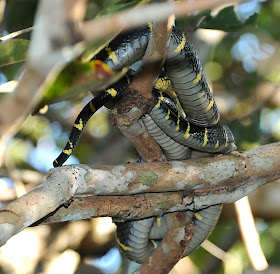A short time before I was to leave Sarawak for the year, I received an invitation from my friend Yeo Siew Teck to accompany him and our friend Kho Kuang to one of the more remote (and recently gazetted, in 2000) national parks in the state. This was Maludam, which protects one of the more extensive stands of lowland peat forest on the northern coast of Borneo. Peat forest is one of the most important ecosystems for biodiversity in Borneo, and is seriously under threat everywhere.
The easiest way to travel into the heart of Maludam is by boat, up the Sungai Maludam, the park's namesake river, from the little fishing village at its mouth. By "boat" I do not mean an ocean-going fishing vessel like this one...
The easiest way to travel into the heart of Maludam is by boat, up the Sungai Maludam, the park's namesake river, from the little fishing village at its mouth. By "boat" I do not mean an ocean-going fishing vessel like this one...
...but a small open dinghy able to navigate the shallow waters of the river, past stands of pandanus and nipa palm (Nypa fruticans), the tree in the upper photograph that looks like a spray of ostrich feathers (the nipa's trunk is underground).
Pandanus spp. (screwpines) can form dense thickets or can arch gracefully into the sky on their own. There are some 600 species in the genus worldwide; in southeast Asia the leaves of one species, P. amaryllifolius, are widely used to add a delicate and sweet flavour to many dishes - something I didn't know before I had the good fortune to marry my Malaysian wife!
Delicate and attractive fan palms grow along the river's edge...
As do other attractive plants that I cannot identify!
The streamside ecosystem grades from mangrove into peatswamp, both habitats for the large and handsome mangrove snake (Boiga dendrophila), also known as the gold-ringed cat snake. "Dendrophila" means "tree-loving", and mangroves snakes are most often found, like this one, in the branches of a tree. This one was my first (and, so far, only) sighting of a mangrove snake in the wild.
Peat-swamp forests are important habitats for pitcher plants (Nepenthes spp.), though their diversity and variety does not match that of the spectacular pitchers of Mount Kinabalu. Four species are found in swamp forest, only one of which (N.bicalcarata) is endemic to Borneo. As we sailed upstream, we frequently passed tangled mats of a much more common and widespread species, Nepenthes gracilis.
Grasshoppers of various kinds (including one that joined us on our boat) were frequent in the riverside vegetation.
We, of course, were birders, so we kept our eyes peeled for larger creatures -- usually without much success. Our best find -- a life bird for Yeo, to my surprise -- was a pair of Great Slaty Woodpeckers (Mulleripicus pulverulentus), Borneo's largest species, tending a nest cavity. This rather poor "record shot" is the closest I could get. Birdlife International has recently listed the Great Slaty as Vulnerable despite its broad range, from India to the Philippines and Indonesia. It prefers primary forest, and as ths forest has been cleared its population may have fallen by between 30% and 49% in the past twenty years.
Maludam is particularly important for primates. It has the only viable population of red banded langur (Presbytis melalophos cruciger) in the world; the langurs apparently live mostly in the eastern and western sectors of he park along the coast, and we did not see them. We did see quite a few of the other key primate of Maludam, the proboscis monkey (Nasalis larvatus). Maludam holds what is probably the largest and most important population of proboscis monkeys left in Sarawak, including this fine old male eying us as we pass.
Proboscis monkeys are wonderful creatures, and I mean no offence to their dignity, but whenever a male turns away from us I cannot help imagining that he is wearing underwear.
At the end of our voyage we turned downstream and headed out the river mouth to the edge of the sea, lined with mangrove and casuarina trees, and the distant coast beyond. The rest of our exploration of Maludam would have to be by land.




















My mom's hometown ^^,
ReplyDelete